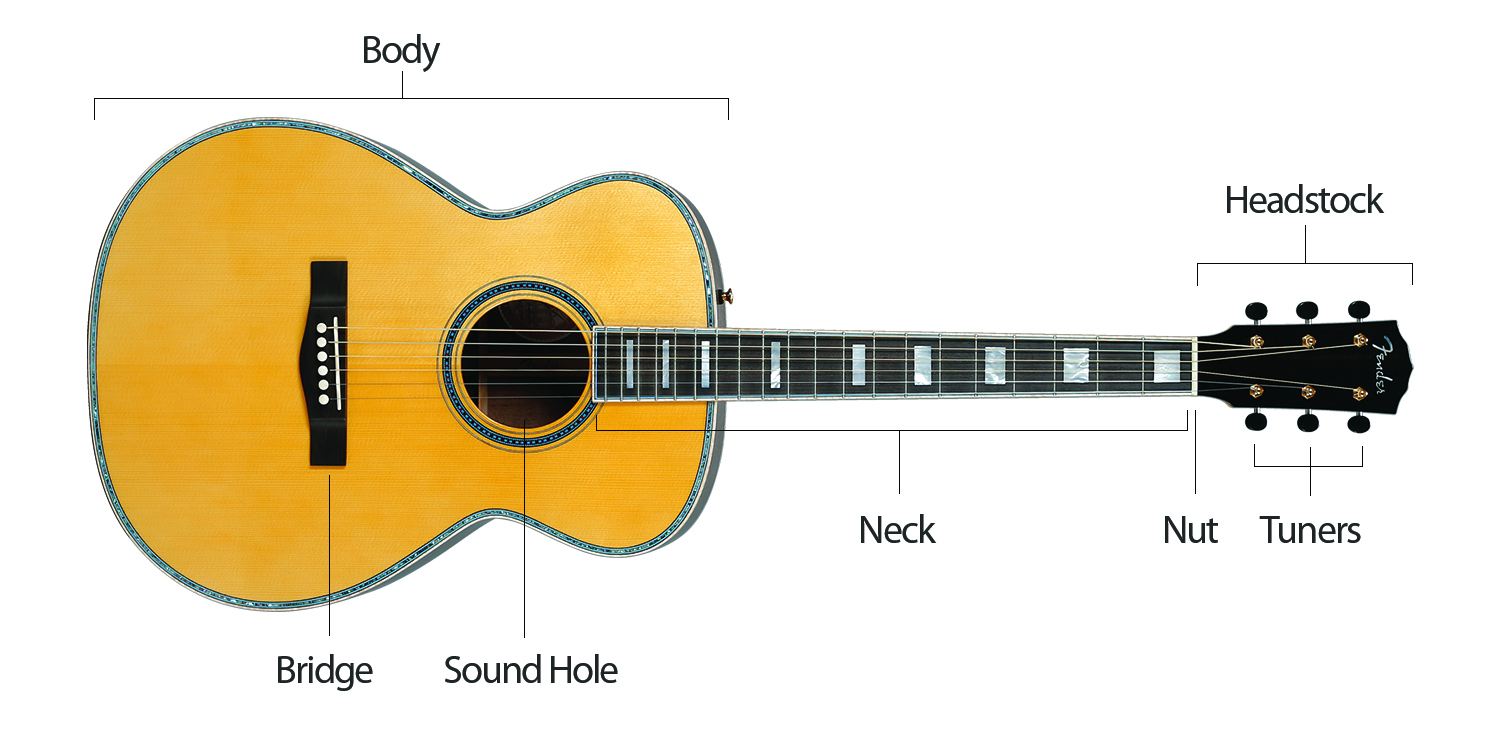
Parts of the guitar
Although there are many different types of guitars (acoustic, electric, classical, electric-acoustic, etc.), they all have many things in common. The diagram above illustrates the various parts of a guitar.
Body
The neck of the guitar adjoins the “body” of the instrument. The body of the guitar will vary greatly from guitar to guitar. Most acoustic and classical guitars have a hollowed out body, and a “sound hole”, designed to project the sound of the guitar. Most electric guitars have a solid body, and thus will not have a sound hole. Electric guitars will instead have “pick-ups” where the soundhole is located. These “pick-ups” are essentially small microphones, which allow the capture the sound of the ringing strings, allowing them to be amplified.
Bridge
A bridge is a device that supports the strings on a stringed musical instrument and transmits the vibration of those strings to some other structural component of the instrument—typically a soundboard, such as the top of a guitar or violin—which transfers the sound to the surrounding air.
Headstock
At the top of the guitar in the illustration is the “headstock”, a general term which describes the part of the guitar attached to the slimmer neck of the instrument. On the headstock are “tuners”, which you will use to adjust the pitch of each of the strings on the guitar.
A headstock or peghead is part of a guitar or similar stringed instrument such as a lute, mandolin, banjo, ukulele and others of the lute lineage. The main function of a headstock is to house the pegs or mechanism that holds the strings at the “head” of the instrument. At the “tail” of the instrument the strings are usually held by a tailpiece or bridge. Machine heads on the headstock are commonly used to tune the instrument by adjusting the tension of strings and, consequentially, the pitch of sound they produce.
Neck
The neck of the guitar is the area of the instrument you’ll concentrate a great deal on: you’ll put your fingers on various places on the neck, in order to create different notes.
The neck of a guitar includes the guitar’s frets, fretboard, tuners, headstock, and truss rod. The wood used to make the fretboard will usually differ from the wood in the rest of the neck.
Marker dots (see Inlay (guitar)) on the face of the fretboard are usually placed at frets 3, 5, 7, 9, 12 (double dot to indicate the octave), 15, 17, 19, 21, 24 (double dot to indicate the second octave). It’s also common that there are marker dots on the side of the neck, near the edge of the fretboard, where the player can easily see which fret he or she is on. Sometimes the dots are replaced with bars, the octave positions having a wider bar. Classical guitars almost never feature position markers, especially on the fretboard’s face, whereas electric guitars usually do.
Nut
At the point in which the headstock meets the neck of the guitar, you’ll find the “nut”. A nut is simply a small piece of material (plastic, bone, etc.), in which small grooves are carved out to guide the strings up to the tuners.
No matter what type of stringed instrument you have, the nut is one of the most important parts of the overall performance, playability and tone of your instrument. It is amazing the effect of upgrading this small part will have on the health of your instrument. When nuts are worn out or poorly constructed, problems such as string buzz, fretting out and tuning performance are just a matter of time.
Sound Hole
A sound hole is an opening in the upper sound board of a stringed musical instrument. The sound holes can have different shapes: round in flat-top guitars; F-holesin instruments from the violin or mandolin families and in archtop guitars; C-holes in violas da gamba, and rosettes in lutes. Bowed lyras have D-holes and mandolinsmay have F-holes, round or oval holes. A round or oval hole is usually a single one, under the strings. F-holes and D-holes are usually made in pairs placed symmetrically on both sides of the strings. Most hollowbody and semi-hollow electric guitars also have F-holes.
Though the purpose of sound holes is to help acoustic instruments project their sound more efficiently, the sound does not emanate solely (nor even mostly) from the location of the sound hole. The majority of sound emanates from the surface area of both sounding boards, with sound holes playing a part by allowing the sounding boards to vibrate more freely, and by allowing some of the vibrations which have been set in motion inside the instrument to travel outside the instrument.
Strings
The strings of the guitar run from the tuning pegs, over the nut, down the neck, over the body, over the sound hole (or pick-ups), and are anchored at a piece of hardware attached to the body of the guitar, called a “bridge”.
A string is the vibrating element that produces sound in string instruments such as the guitar, harp, piano, and members of the violin family. Strings are lengths of a flexible material that a musical instrument holds under tension so that they can vibrate freely, but controllably. Strings may be “decorative” (consisting only of a single material, like steel, nylon, or gut). “Wound” strings have a “core” of one material, with an overwinding of other materials. This is to make the string vibrate at the desired pitch, while maintaining a low profile and sufficient flexibility for playability.
Tuners
A tuning peg is used to hold a string in the pegbox of a stringed instrument. It may be made of ebony, rosewood, boxwood or other material. Some tuning pegs are ornamented with shell, metal, or plastic inlays, beads (pips) or rings.
Turning the peg tightens or loosens the string, changing the pitch produced when the string is played and thereby tuning it.
